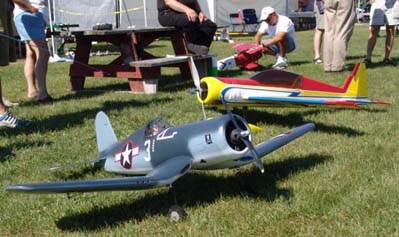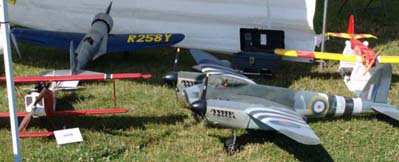 |
Flying High With Electric Power!
The Ampeer ON-LINE!
Fly the Future - Fly Electric! |
Site Table of Contents
| President: | Vice-President: | Secretary/Treasurer: |
| Ken Myers | Richard Utkan | Rick Sawicki |
| 5256 Wildcat | 240 Cabinet | 5089 Ledgewood Ct. W. |
| Croswell, MI 48422 | Milford, MI 48381 | Commerce Twp., MI 48382 |
| (810) 679-3238 | (248) 685-1705 | 248.685.7056 |
 | ||
| Board of Directors: | Board of Directors: | Ampeer Editor |
| David Stacer | Jack Lemon | Ken Myers |
| 16575 Brookland Blvd. | 8908 Sandy Ridge Dr. | 5256 Wildcat Rd. |
| Northville, MI 48167 | White Lake, MI 48386 | Croswell, MI 48422 |
| 248.924.2324 | 248.698.4683 | 810.679.3238 |
| Mailed Ampeer subscriptions are $10 a year US & Canada and $17 a year world wide. FREE on-line! | ||
| The Next Meeting: Date: Saturday, Oct. 1 Time: 10:00 a.m. Place Midwest RC Society 5 Mi Rd. Field - Mid-Am | ||
|
From Mike Southwood michael.southwood@ntlworld.com
SPECIFICATIONS:
GENERAL Power Class: Electric Class: Park Flyer Category: Aerobatic | Scale Flying Skill: Intermediate, Build Type: RTF (optimistic claim)
FIRST IMPRESSIONS:
Opening the pretty box, everything inside was packed well in polythene bags. Nothing was damaged and it all looked to be of high quality. Two sets of decals, one for a blue plane and one in Red. These also help strengthen the rather flimsy polystyrene board parts. CLOSER LOOK: The fuselage is blow moulded from a thin ABS type material. I found that in some areas it has been thinned by the process and is very weak. The wing support flanges at the back were very thin.
Tail feathers are made from Polystyrene foam boards. They have to be reinforced in various ways, by the addition of plastic self-adhesive card.
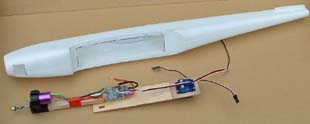 This was my original attempt at using the 4:1 gearbox and stick mounting. This did not work out very well, so the motor was removed from the gearbox and fitted in the usual way. The servo plate broke, being light plywood; it was very weak around the servo cutout. A ply plate was glued on.
ASSEMBLY: The instruction book is very comprehensive. Without it, assembly would be difficult, even for an experienced builder. Even with it, the task is not easy! There are so many parts, mostly bits of self-adhesive plastic board that have to go on the correct place and at the right time. Wings are moulded polystyrene. Well finished and with a slightly hard outside skin. They have a hard plastic sheet leading edge wrapped on. The ailerons have to be cut at each end to allow hinging, using the thin moulded foam hinge. These have to be bent about for a while until reasonably free. They are quite flexible and tend to twist when operated, giving more movement at the root. Not a bad thing, self-adjusting pitch! The operating arms are thin wire, pre-bent and threaded for the connections. Epoxied in place and covered with plastic card squares, it works quite well, despite being crude. The two halves are glued together with epoxy while the wing is laid on a flat, straight board topside down. The match was perfect and the result was a true wing. If I did it again, I would not apply epoxy where the front peg goes. The epoxy being harder than the foam, makes drilling in the centre very difficult! Clear plastic tape (not supplied) had to be used to cover the joint and strips placed along the wing to add bending strength. A bit ugly to my eyes. A ply plate is glued on underneath to reinforce the back screw fixing. A reinforcing board on top finishes the job, adding strength to the centre section. Fuselage This has to be cut out where the wing seats, leaving about a 3/8" flange all around. At this point it is very thin and care has to be taken. I had to add reinforcement at the back corners. A ply wing fixing plate is glued in. I found the plastic very difficult to glue to, even after cleaning and roughening up, the epoxy did not stick easily. Probably coated with mould release! A few holes have to be drilled right on the centre mould line, which is raised and thick. It is difficult to do without slipping off centre.
FINISHING: The application of all the decals, proved to be quite easy. They certainly improve the looks. I used the red set, hoping to make it easier to see in the air. I suspected at this time that it would go very fast. BALANCE: The manual gives clear instructions on how to balance and where. 2-3/8 in, behind the leading edge. They advise putting marks on the top of the wing and balancing upside down. In my case, even with the Li-Poly pack pushed right in to the nose, it was still tail heavy. As it is so much under weight the solution is to go up to an 1800 mAh Li-Poly rather than use extra lead. (I hate having to add weight to balance!) FINAL READY TO FLY: The finished model has ended up at 14 oz. That is 3 oz less than specified on the box lid. The motor is much lighter and the undercarriage saves a bit. It looks quite nice from a distance, but I have a feeling that flying the thing will be difficult. It is heavier than my Alfa Models Corsair, with less wing area and a much thinner wing. It should fly a long time on the 1800 Li-Poly! A BIT MORE DETAIL:  The little 280 brushless motor with gearbox removed. Size: 30mm X 20mm. Voltage 6V - 12V, Turns 8. On 11.1V, 7500 rpm with 10 X 4.7 prop. 13000 with 6 x 3.5 prop. 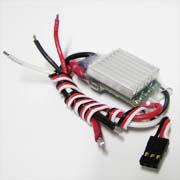 Brushless Speed Controller HM - 18A Constant current 15 Amps. Maximum 18 Amps. BEC 1.5A 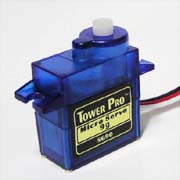 SG - 90 Micro Servo 9g weight, Dimensions: 22*11.5*27mm *Operating Speed (4.8V no load): 0.12sec/60 degrees *Stall Torque (4.8V): 17.5oz/in (1.2 kg/cm) *Temperature Range: -30 to +60 Degree C *Dead Band Width: 7usec Operating Voltage:3.0-7.2 Volts  REX 4 plus: 4 channel, FM single conversion receiver band: 27, 35, 36, 40, 41 MHz dimensions: 31 x 24 x 14 mm weight: 10 g X-tal: standard  CODE: LI1811 NAME: 1800mAh/11.1V 8C EP Series Li-poly battery pack W/Tap CATOGRY: Electronic BRAND: HiModel WEIGHT: 129g(4.6oz) SIZE: 72x34x28mm Flight Report I have had two flights with Reno Racer. Fitted with an 1800mah Li-Poly to get the balance almost right. It flew without any trim from a hand launch in to a fairly strong wind, about 6 mph gusting to 10 mph. It is very fast and quite twitchy. Being so small, it is easy to get too far away very quickly and with my 71 year old eyes, despite my new Axis Ranger special sun glasses, it was a difficult flight. Unlike the Alfa Corsair, which can be flown over our patch with ease, the Reno prefers high speed and smooth large manoeuvres. There is plenty of power and about 15 minutes of duration before I got fed up! I deliberately stalled it at a good height. It dropped a wing very sharply and required power to bring it out. Pulling tight turns was also a danger especially as the wind got on its tail, an instant flick dive / spin. Landing had to be fast and flat. At least with power to spare one could open up and climb away at about 45 degrees. Rolls are straight and fast, but it is not a plane for beginners or slow reactions. An interesting experience, but a model to sell on quickly, before I break it!
Update on the Tiger 2 Conversion Found in the September Ampeer
Hi Ken, I just thought I would email you about my Tiger 2 conversion that I sent you last month. I am now using 2- 3S2P 4160 Appogee Li-Po packs. The performance is better than I hoped, as it now has shed over a pound of battery weight and provides sparkling performance for more than 10 minutes.
Cheers and regards to all,
Piper J-3 Cub on Floats
Dear Ken, I just recently added floats to this 2000 Piper J-3 Cub, and it looks like a real winner. It's really lively on the water with a new MEGA 600/20/5 Outrunner Motor using a 10 x 5 prop.
It should be ready to take to the air in just a few days. It flew great as a landplane, and should be fine on floats. Most modelers would agree, "There's nothing as pretty as a Piper J-3 Cub on floats!"
I assume you are using the Sanyo CP-1300 at 1.16 oz. each or about 12.2 ounces for a 10-cell pack with wire and connectors. The Gold Peak GP-2200 NiMH cells weigh 1.62 oz. each for a pack weight with wire and connectors of about 17 ounces. I would believe this plane is capable of handling the extra 5 ounces quite easily, without changing the flight characteristics very much. KM Addendum: Thank you for your reply on the Moose, and Batteries. On the Moose, we will keep our distance but hope to see some. (Yes, folks we were talking about real Moose, not Martin's plane. How many of you remember that one? KM)
And More:
I can only hope that you'll be as pleased as I am! I drove over to the fairly local Thompson dam Float Fly in Eastern Connecticut on Saturday to be there early on Sunday, the day of the event.
The day started out beautifully, but got progressively windier. By 1:00 PM it has started to rain. Fortunately I was able to get a flight in before that occurred.
Best wishes from the Cape, and hope to see you at the NEAT Meet,

Cub on takeoff run Small Motor Data
Ken, Over the past few months I've been experimenting with a little foamie flying wing that Hobby-Lobby used to sell -- The Direct. It came with a Multiplex 280 motor, and a 125x110 mm prop (the same prop as used on the Wingo).
Best regards,
|
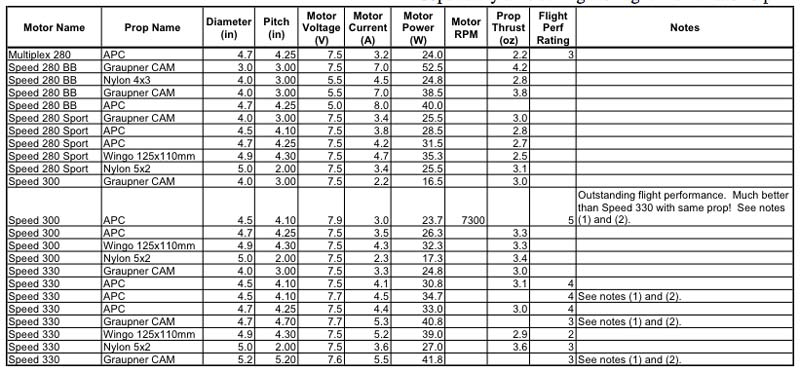
|
The "Flight Perf Rating" is an integer from 1 to 5, where 1 is poor and 5 is excellent. Based on a ~14oz EP flying wing. Static thrust measurements taken with an electronic postage scale.
In all test cases, power was supplied by a Tenma 72-630A 30 Amp variable power supply, unless noted otherwise.
Notes:
J. Yuzwalk
Czechmate Flies!
Here is just a short 'news release' of the test flight on Czechmate. To remind everyone, it is a 1/6th scale model of the Reno Gold Unlimited Racer, a very highly modified Yak-11.
Take care,
If you think things always go right, even for a great modeler like Keith, here's a little of what didn't go quite right with the birthing of this plane. KM Hi All, Thought I'd relate a story for your enjoyment and horror. On Monday, I finally had all the parts to bench run the 'Astro Monster' prototype 90. I set it up on my portable Workmate in the driveway, carefully taped down the tach, Whattmeter, receiver and battery, 9s1p 3.2Ahr Kokam pack, and transmitter. The Castle 85amp HV controller was programmed, 16x13 pattern prop attached, and with a very good grip on the Work-mate, the throttle was slowly increased. At a couple of amps it was already pushing quite a bit of air, somewhere around 30 amps it took noticeable effort to restrain the bench from trying to fly. I watched with glee and amazement as the current climbed to 70 amps, 2200 watts, and 8600 rpm. My biceps were *really* straining, even with both hands it was a struggle. I let it run wide open for 1.5 ahr (a little over a minute), the rpm holding at 8300@67amp@2000 watts. WOW! I would estimate static thrust around 25-30 POUNDS or maybe more.
We live and learn. Even me. Keith PS: Fortune cookie thought for the day: "The measure of time to reach your next goal is the measure of your discipline" Very appropriate. |
The Mid-Am 2005 Report
As I write this, it has been a couple of months since the Mid-Am. That hardly seems possible. This is, as Larry Marshall called it, more of a party for 100 of our best friends. Keith and I relish this aspect of the meet very, very much. We must, as we've been doing it for 20 plus years. It is hard to believe that Keith will be sixty the next time the meet rolls around, and I will be sixty the month after. My goodness, where has the time gone?

Part of Vendor Row, 2005 SR Batteries, Inc.
Over the years, it has been our goal to keep this a pilots' meet, one where the pilots can fly and demonstrate your latest creation. We’ve seen a lot of changes in electrically powered RC aircraft since the mid-80's. Here is a listing of some of the outstanding planes and pilots of this years meet. Best Sport Plane Bob Livin's Antic
Sunday's Awards Best Multi-motor - Laddie Mikulasko's Blohm & Voss Tri-Motor
The Charlie Spear Award Charlie Spear was a very fine gentleman, who was an early electric columnist spreading the Electric word, along with his good friend and partner, Dr. John Mountjoy. When Charile passed away, Keith and I decided that we would honor the memory of this fine man with this award. Before the Mid-Am Keith and I discuss some possible nominees and decide who will receive this prestigious award. This year we selected Don Belfort. Don is a columnist for Flying Models and participates in the electric flight AMA Nationals. He has built some of the most unique electric planes over the years. His creativity and problem solving can be seen in each and every plane he builds and designs. He is an outstanding "E" modeler, and we consider him a great friend as well. Congratulations Don. We are proud to add your name and contributions to the plaque along with Ken Myers, Dr. John Mountjoy, Bob Kopski, Bob Boucher, Martin Irvine, Jim Ryan, Jim Bourke, Bob Aberle, Doug Ingraham and Dave Grife. One of the great traditions of this gathering is the Saturday night pot-luck, featuring steak sandwiches. The Hare's family, lead by Dave, seems to have been putting this on "forever", and we thank them for there efforts through all these years! Following the potluck, the flying continues well into the night. This is when Ken and Keith get some time to relax and Keith is usually asked to checkout someone's new creation. 
Always fun to visit with old friends like Doug Ingraham with his geared AF25. After sunset, there were several planes flying with various lighting means. Someone set up a monitor and showed videos of Saturday's activities, and then fireworks appeared over Mount Trashmore. When the fireworks were over, the star of the evening appeared. No, it was not a star in the sky, but Midwest RC Society president, Howard Kendall, and his uniquely lighted 3-D glow helicopter. His demonstration of nighttime lighted 3-D flying has to be seen to be believed. As the helicopter goes through its routine, the various lights change colors. As in years past, everyone stands in awe and silence, watching intrigued that anyone can fly that well in total darkness. There is little sound from the folks watching, only slight breathing and an occasional gasp. When the flight ends, the clapping is thunderous, and cheers and whistles riotous. He is a master showman, and we really appreciate his taking the time to share his skill and joy of the hobby with us. To all of you pilots who came, and have come over all these years, Keith and I say thank you for sharing with us. Thanks for sharing your creations, enthusiasm and you. It is wonderful to know that we modelers are the greatest group of folks on this planet, and those that come to our "quiet little party", the absolute best of all. Thank you, one and all! 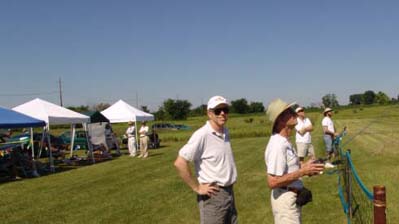
Tom and Jim enjoy the fine weather early in the day.
For an excellent write-up, more photos and video of this "E"vent, visit Jim Bourke's Ezone Magazine, for the article by Jim Young and Chris True, www.rcgroups.com/links/index.php?id=4838 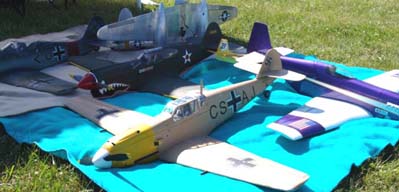
Some of Mark Rittenger's great flying sport scale planes. 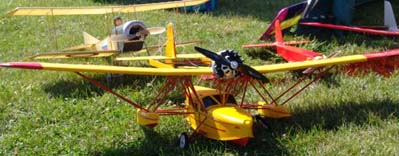
Al Mrock's S-39 with scale bipe in back. Is there a theme here? |
To Reach Ken Myers, you can land mail to the address at the top of the page. My E-mail
address is:
KMyersEFO@mac.com
EFO WEBsite: http://members.aol.com/KMyersEFO/
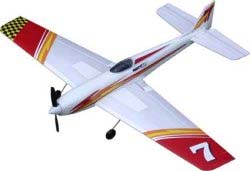
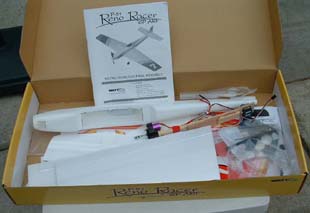

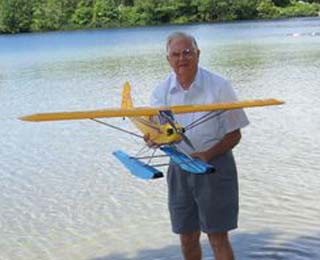
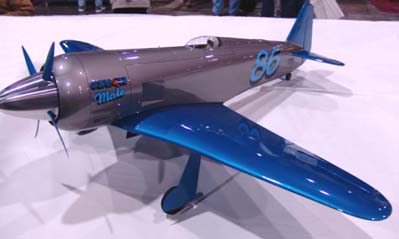
 We've Come a Long Way, Baby!
We've Come a Long Way, Baby!
